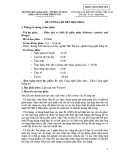
It’s those famous tree-hugging eco’ architects again, Adrian Smith and Gordon Gill with yet another magical
mode of harnessing the elements. Not content with the latest mediocre building-integrated wind turbine
technology, they have to go and re-invent the whole wind capture thing again, and to top it all it looks
amazing! Certainly not just for show, the design for the Clean Technology Tower – Chicago is certainly an
environmental eye-opener, creating a marvel of biomimicry
that utilises site-specific air streams to feed the tower’s
power-producing dynamos. The giant atrium-style shell of the
building employs strategically-located air funnels, drawing
air in and maximising wind velocity. The turbines sandwiched within the structure are literally axle-bent as a
result, and coupled with the solar roof cap produce ample power for the intended 1.8-million-square-feet of
office space, spa, hotel and retail spaces below.
Welcome to Zerohouse, a
shining example of prefabricated
living space designed to be
completely self-reliant and, of
course, luxurious. This comfort
mini-home started as a pet
project for Architects Specht
+ Harpman, but on release it
had eco-home
buyers queuing
round the block
for a piece of
the pre-fab
action. This
fervent demand
should put the concept in to
production very soon. The luxury
mini-home can be erected in
a day, provides its own power
generation, water collection and
storage, and waste processing.
Occupants will literally melt in
to a wall of comfort with the
luxury fittings and furniture, all
bespoke-mounted within the
thermal structure to maximise
living space. The home is also
fully-automated using the
latest power-saving smart
gadgetry. We are convinced that
Zerohouse will do more than
just provide guest housing for
people with large plots of land,
its primary intended purpose
(and at 600 grand a pop I
should say so too! A small price
however for something of such
cool design stature, with such a
delicate footprint on the planet).
Green product design is one of the
world’s fastest growing industries
and the rewards can be massive; be
they prize donations or just sound
product sales, there are potentially
bundles of green dollars at the
end of the rainbow for successful
candidates. At the end of last year
Sir Richard Branson announced a
$25-million prize fund, tempting
scientists to devise an innovative
process of extracting greenhouse
gases from the atmosphere. His
theory is that man created the
problem, so man should solve it.
Perhaps,then,he should tear down
his Virgin Galactic complex and
replant the trees, helping plug some
holes in the ozone layer rather
than trying to bust through it and
escape our impending doom?! Sadly,
the competition remains open and the
problem unsolved, but hats off to
him if it bears fruit.
Meanwhile, it’s down to the
inventions to hook us up, the ones
that make a bit of difference, and
if employed correctly can make a
bit of difference a billion times
over. That’s where we all come in,
of course - but our chronically
habitual souls remain very hard to
sway.
Smooth Operator
Off The
Grid
Housing
Images 1 & 2 (opposite page)
- Clean Technology Tower....
rendering shows atrium-style shell
that utilises site-specific air-streams
to power the building. (© Adrian
Smith + Gordon Gill Architecture)
Images 3 & 4 (this page) -
Zerohouse.... erected in a day, this
self-reliant abode could very well be
the shape of homes to come.
(© Scott Specht for Specht Harpman)
3
4

How’s this for advanced architectural innovation? A design
competition for the skyscraper of the future has thrown up some
interesting results. A pair of independent architects have ingeniously
come up with a design that has rocked the very foundations of
sustainable architecture.
This spiralling Fog Tower is intended
for use on the edge of the Atacama
Desert, northern Chile where it
would render one of the driest
areas on earth habitable and productive. The huge surface area of
this amazing symbiotic super- structure would capture the moisture
from a dense north Chilean sea fog and channel the water down to
its processing underbelly. Here trace minerals from the sea would
be filtered using an efficient reverse osmosis system. The resulting
20,000 to 200,000 litres of water produced per day would allow for
the development of a sustainable agriculture environment that the
area and its occupants badly need.
Fog Tower
Microchips operating from body heat
Harvesting Fuel
From The Air
To be able to extract Co2 from the air is
one thing, but then what do you do with
it? There are only so many ways to dispose
of the copious quantities of this noxious
gas. This problem has been tackled by
researchers from the Los Alamos Research
laboratory who have recently announced
a groundbreaking new project called
Green Freedom. They have devised a
way to capture the greenhouse gas
and convert it into fuel to power cars
and aircraft; at least that is the idea. The
technology would involve smothering
existing Co2-emitting energy plants with
carbon-capturing equipment; a kind of
giant ‘carbon condom’ if you like, charged
with shielding the fertility of mother
nature! The gases would be retained
and then converted using a form of
electrochemical separation. This magical
process would create a double edged
eco-sword, attacking the existing problem
of greenhouse gases already at large and
preventing new ones being released in to
the air. Green Freedom would provide a
large-scale production method for carbon-
neutral, sulphur-free fuels and organic
chemicals from air and water. The idea is
yet to be proved economically viable but
it remains a very encouraging concept in
the ensuing battle of the gases, so fingers
crossed on this one.
A late sixties invention that kind of caught on – slowly at first but now pretty much operates
everything we lay our hands on. While rapidly shrinking in size, science has yet to devise
a similar decrease in the amount of power the miniscule microchip consumes. All that
calculating makes these tiny electronic critters seriously energy-hungry, a problem that
restricts technology mobility. But how would it be if microchips were more energy-efficient?
A question a group of scientists at MIT asked themselves and set about solving. They have
now devised a chip that barely snacks on power, and consequently can be recharged by
our own body heat! This ‘weight- watcher’ chip operates at less than one third voltage-
consumption than its predecessors and the prospects are looking good. Hundreds of
applications such as pacemakers and mobile phones will be powered or recharged purely
by the energy we produce in hauling ourselves around. A few technical difficulties lay in the
manufacturing process but the scientists believe the chip will be available commercially
within five years.
(continue from page 54)
Opportunely, these revolutionary designs are incredibly appealing
and cultivate an evolving trend that finally runs in tandem with our
delicate eco system. The trend is gathering momentum too; history
dictates that war is the mother of invention, the great conflicts
generating a rush to create war-winning technologies. This relatively
new carbon-conflict is no exception to the rule and things are
getting quite exciting. And don’t worry; the big corporate companies,
oil industries and governments will eventually sit up and listen as
this colorful industry swells into a viable revenue platform – it’s
now up to us to get it to that point.
We have picked but a few of our favorite structures, energy ideas and
sustainable concepts for your perusal – some of which we are sure can
make the difference, or at least give us that morsel of hope we all
desperately need to act on…. while there is still time!
Image - Fog Tower....transforming what was once dry and uninhabitable into an agricultural environment, this design completely redefines sustainable
architecture. (© Adrian Smith + Gordon Gill Architecture)


The Polaroid Book:
25th Anniversary Special Edition
Cannes Film Festival 2008
Architecture Now! 3: 25th Anniversary Special Edition
Author: Philip Jodidio
Good old Taschen, we can always count on the luxury publisher to come up with something to feast our
greedy eyes on. This month they’ve released a 25th anniversary edition of Architecture Now! 3, a stunning
tome covering the hottest designers and projects around the world. Stuffed with enough cutting-edge
editorial and large-format colour photos to make a grown architect weep tears of joy, this sexy book is a must-
have for your bare coffee table. Featuring big-name designers, including Zaha Hadid, Philippe Starck, Jean
Nouvel and Santiago Calatrava, as well as a host of up-and-coming bright young things, we couldn’t think of
any more nourishing reading material this month. Order it, open it and get stuck in.
Caramel
Director: Nadine
Labaki
The first feature-
length film by
Lebanese director/
actress Nadine
Labaki, Caramel
follows the lives
of five female
friends in a Beirut
beauty salon as
they struggle
with forbidden love, restrictive traditions,
repressed sexuality, getting older, desire
over duty and a culture that’s caught in the
divide between the modern and traditional.
The film is noted for its simple but effective
storyline and its realistic characters, as well as
for showing Beirut as a warm, exotic locale,
rather than a war-torn hellhole. Also co-
starring Labaki, the young talent truly shines
in this stunning, honey-tinged debut.
Author: Barbara Hitchcock
Editor: Steve Crist
Comprising key works by the likes of David Hockney, Helmut
Newton, Jeanloup Sieff and Robert Rauschenberg, the Polaroid
Corporation’s photography collection is arguably the best in the
world. The 25th anniversary edition of The Polaroid Book by Taschen
is a glorious tribute to the collection, and to the medium that defies
the digital age. Despite production of the traditional Polaroid camera
coming to an end, the medium is still favoured by photographers
who appreciate its quirky, vintage-style images – and the proof is in
the pages of this hallowed tome! Featuring over 400 works from the
collection, this 352-page marvel has more than enough substance to
keep you up reading well into the small hours.
Books
Cinema
Summer Palace
Director: Lou Ye
As politically provocative as cinema gets, Lou
Ye’s Summer Palace centres around the real-life
shootings of protesting students at Tiananmen
Square. As a result, the national bureaucracy
banned Ye from filmmaking for five years - but
it was a sacrifice Ye made to tell a story he
obviously feels passionately about. Of course,
the political thread of this movie is used as
a backdrop against a passionate love story
between the central protagonists, Yu Hong
and Zhou Wei. Falling in love during a time of
political revolution isn’t easy, as this film graphically shows. A wonderful,
wide-screen romp – in more ways than one in a number of sexually candid
scenes! – we urge you to see this film so that Yu’s sacrifice wasn’t in vain.
Roll out the red carpet, the Cannes Film Festival is here
again – and it’s in its 61st year! The world’s biggest
celebration of cinema, the 2008 festival will be just as
spectacular as previous editions when it is held from 14th
to 25th May at the seaside resort’s Palais des Festivals.
Judged by a panel of industry experts – actor Sean Penn will
be leading the panel this year – films on show span every
genre imaginable, ranging from big-budget blockbusters
to under-the-radar Indie flicks. Only time will tell who’ll be
walking away with the prestigious Palm d’Or award for best
film this time round, though the industry’s elite will stop at
nothing to get their filthy little mitts on it. So if gorgeous
film stars, glamorous premieres and gigantic P Diddy-style
yachts are your thing, you know where to head this May.
Not that us mere mortals would ever get past the velvet
ropes, mind.

Help us to build a better future in Calcutta, India
www.saberafoundationindia.org | Donations: Banco Santander -
Acct.: 0049-1555-11-2290021421 (IBAN ES64 0049 1555 1122 9002 1421)
For more information call (+34) 913525720 or email kalitala.spain@telefonica.net
We Are
Looking
For
Guardian
Angels
Why not
apply and
take flight?
















![Đề cương bài giảng Mỹ thuật đại cương [mới nhất]](https://cdn.tailieu.vn/images/document/thumbnail/2025/20250715/kimphuong1001/135x160/30821752564027.jpg)









